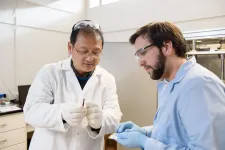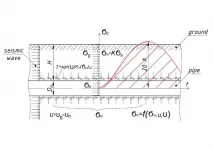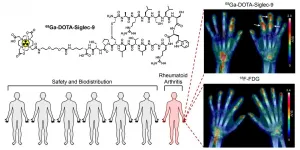(Press-News.org) Look deep inside the brain of someone with Alzheimer's disease, most forms of dementia or the concussion-related syndrome known as chronic traumatic encephalopathy (CTE) and you'll find a common suspected culprit: stringy, hairball-like tangles of a protein called tau.
Such conditions, collectively known as "tauopathies" strike scores of people across the globe, with Alzheimer's alone affecting six million people in the United States.
But more than a century after German psychiatrist Alois Alzheimer discovered tau tangles, scientists still have much to learn about them.
A University of Colorado Boulder study, published this week in the journal Neuron, shows for the first time that tau aggregates gobble up RNA, or ribonucleic acid, inside cells and interfere with an integral mechanism called splicing, by which cells ultimately produce needed proteins.
"Understanding how tau leads to neurodegeneration is the crux of not just understanding Alzheimer's disease but also multiple other neurological diseases," said senior author Roy Parker, a professor of biochemistry and director of the BioFrontiers Institute at CU Boulder. "If we can understand what it does and how it goes bad in disease we can develop new therapies for conditions that now are largely untreatable."
The study was led by Evan Lester, an M.D./PhD candidate in the Medical Scientist Training Program, which enables students to simultaneously work toward a medical degree from the University of Colorado Anschutz Medical Campus and a PhD from CU Boulder.
For part of his medical training, Lester worked alongside doctors and patients at the CU Alzheimer's and Cognition Center in Aurora.
"There is nothing we can do for these patients right now - no disease modifying-treatments for Alzheimer's or most of the other tauopathies," Lester said, noting that 70% of neurodegenerative diseases are believed to be at least partially related to tau aggregates.
For the study, the researchers isolated tau aggregates from cell lines and from the brains of mice with an Alzheimer's-like condition. Then they used genetic sequencing techniques to determine what was inside.
They confirmed for the first time that tau aggregates contain RNA, or ribonucleic acid, a single-stranded molecule key for synthesizing proteins in cells. They identified what kind of RNA it is, specifically snRNA, or small nuclear RNA, and snoRNA, or small nucleolar RNA.
They also discovered that tau interacts with pieces of cellular machinery known as nuclear speckles, sequestering and displacing proteins inside them and disrupting a process called RNA splicing in which the cell weeds out unneeded material to generate new, healthy RNA.
"The tau aggregates appear to be sequestering splicing-related RNA and proteins, disrupting their normal function and impairing the cell's ability to make proteins," said Lester.
Notably, scientists examining the brains of Alzheimer's patients after death have discovered evidence of splicing-related defects in cells.
The paper is the first in a series out of Parker's lab to explore the mechanism of action by which tau aggregates gum up the works inside brain cells.
Already, several companies have clinical trials underway testing drugs that would do away with tau entirely in patients with neurodegenerative diseases. But that could potentially have unintended consequences, said Lester.
"A big problem in the field is that no one really knows what tau does in healthy people and It likely has important functions when not in tangles," he said.
By better understanding precisely what it does to harm and kill cells, Parker and Lester hope to bring a different approach to the table.
"The idea would be to intervene in the abnormal functions while preserving the normal functions of tau," Lester said.
INFORMATION:
What The Study Did: The fitted filtration efficiency of commonly available masks worn singly, doubled or in combinations was evaluated in this study.
Authors: Emily E. Sickbert-Bennett, Ph.D., M.S., of the UNC Medical Center in Chapel Hill, North Carolina, is the corresponding author.
To access the embargoed study: Visit our For The Media website at this link https://media.jamanetwork.com/
(doi:10.1001/jamainternmed.2021.2033)
Editor's Note: The article includes conflict of interest and funding/support disclosures. Please see the article for additional information, including other authors, author contributions and affiliations, conflict of ...
CHAPEL HILL, NC - A study published today in JAMA Internal Medicine shows that wearing two face coverings can nearly double the effectiveness of filtering out SARS-CoV-2-sized particles, preventing them from reaching the wearer's nose and mouth and causing COVID-19. The reason for the enhanced filtration isn't so much adding layers of cloth, but eliminating any gaps or poor-fitting areas of a mask.
"The medical procedure masks are designed to have very good filtration potential based on their material, but the way they fit our faces isn't perfect," said Emily ...
Thermoelectrics directly convert heat into electricity and power a wide array of items -- from NASA's Perseverance rover currently exploring Mars to travel coolers that chill beverages.
A Clemson University physicist has joined forces with collaborators from China and Denmark to create a new and potentially paradigm-shifting high-performance thermoelectric compound.
A material's atomic structure, which is how atoms arrange themselves in space and time, determines its properties. Typically, solids are crystalline or amorphous. In crystals, atoms are in an orderly and symmetrical pattern. Amorphous materials have randomly distributed atoms.
Clemson researcher Jian He and the international team created a new hybrid compound in which the crystalline and ...
Russian scientists have proposed a theory of phase transformation in polymer gels. It explains the mechanisms of the dramatic reduction in volume of zwitterionic hydrogels when they are cooled. The results are published in the journal Chemical Communications (ChemComm).
Polymer gels have unusual properties, including the ability to absorb water in volumes hundreds of times greater than their own. For example, some hydrogels are capable of holding up to two kilograms of water per gram of dry gel. By changing the temperature or adding solvents, various desired properties can be achieved. This is why polymer gels are used in industry and biomedicine, including for the targeted delivery of medication, creation of artificial skin, children's toys, etc.
If you take ...
Two new studies published in Blood suggest that the mRNA COVID-19 vaccine may have reduced efficacy in individuals with chronic lymphocytic leukemia (CLL) and multiple myeloma, two types of blood cancer. According to researchers, these studies could help inform the ideal time for vaccination of these populations.
Study suggests two-dose COVID-19 vaccine is less effective for people with CLL as compared to healthy controls
The first study reports that people with CLL had markedly lower immune response rates to the two-dose mRNA COVID-19 vaccine than healthy individuals ...
Underground pipelines that transport oil and gas are very important engineering communications worldwide. Some of these underground communications are built and operated in earthquake-prone areas.
Seismic safety or seismic stability of underground pipelines began to be intensively studied since the 1950s.
Since then, a number of methodologies were proposed for calculating stress received by an underground pipeline during an earthquake. The purpose of these methodologies was to make an accurate prediction on the structural stress received by a pipeline during an earthquake, and thus it would allow to decide ...
A virtual human can be as good as a flesh-and-blood one when it comes to helping people practice new leadership skills. That's the conclusion from new research published in the journal Frontiers in Virtual Reality that evaluated the effectiveness of computer-generated characters in a training scenario compared to real human role-players in a conventional setting.
Practice-based training techniques, including role-playing, are sometimes used to help improve training outcomes. However, these methods can be expensive to implement, and often require specialized knowledge and even professional actors to create realistic training environments. In addition, some ...
The preliminary trial results of a novel radiopharmaceutical for PET imaging of inflammation developed at the University of Turku, Finland, have been published. The compound, which targets the vascular adhesion protein 1 (VAP-1) that regulates inflammatory cell traffic, is the first radiopharmaceutical that has been developed completely in Finland and has advanced to clinical trials. In the study that started with healthy volunteers, the radiopharmaceutical was found to be well tolerated and safe.
The radiopharmaceutical is 68Ga-labelled Siglec-9 peptide.
"The dose of the radiopharmaceutical ...
"It is machination, it is deception," said the Director General of the Berlin Royal Museums in his defence when criticized for buying a fake. Wilhelm Bode did not budge an inch: the sculpture he acquired in 1909 was an as yet unknown production of the great Renaissance master, Leonardo da Vinci. After one hundred years and numerous controversies, a group of scientists led by a CNRS researcher* has just proven him wrong once and for all. The Flora wax bust, conserved at the Bode Museum in Berlin, recently underwent radiocarbon (14C) dating, which provided both a precise date and an incontrovertible result: it was made in the nineteenth century, nearly 300 years after da Vinci's death. As the sculpture was made primarily from spermaceti, ...
The life of almost all animals in the ocean depends on the availability of oxygen, which is dissolved as a gas in seawater. However, the ocean has been continuously losing oxygen for several decades. In the last 50 years, the loss of oxygen accumulates globally to about 2% of the total inventory (regionally sometimes significantly more). The main reason for this is global warming, which leads to a decrease in the solubility of gases and thus also of oxygen, as well as to a slowdown in the ocean circulation and vertical mixing. A new study published today in the scientific journal Nature Communications ...






